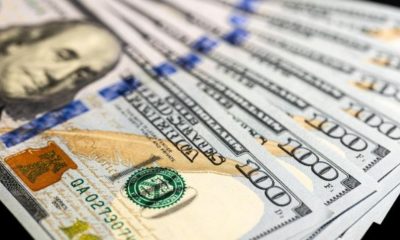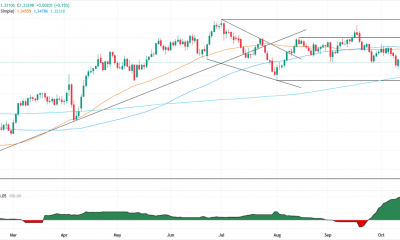

others
Gold trades with mild negative bias ahead of FOMC Minutes – Crypto News
- Gold price trades with mild negative bias in Wednesday’s early Asian session.
- The cautious approach from Fed officials weighs on precious metals.
- Gold traders will monitor the FOMC Minutes and Fed’s Goolsbee speech.
Gold price (XAU/USD) trades on a negative note on Wednesday after retreating from a record high on Monday. Members of the Federal Reserve (Fed) warned that the US central bank needed much more convincing that inflation was easing before it could begin cutting interest rates, emphasizing the Fed is likely to keep rates higher for longer. This, in turn, might boost the Greenback and weigh the USD-denominated gold lower.
Nonetheless, the yellow metal’s downside might be limited amid the renewed US-China trade tensions, Middle East geopolitical tensions, and the strong demand from central banks and Asian buyers, which might provide some support to the yellow metal. Later on Wednesday, gold traders will keep an eye on FOMC Minutes, along with the Fed’s Goolsbee speech.
Daily Digest Market Movers: Gold price edges lower as uncertainties over US interest rates persisted
- Fed Governor Christopher Waller said that he does not think further rate hikes will be necessary, adding he will need some convincing data before he backs cuts anytime soon.
- Atlanta Fed President Raphael Bostic noted that the US central bank has to be cautious about the first-rate move. Bostic further stated that he would “rather wait longer for a rate cut to be sure inflation does not start to bounce around.”
- Cleveland Fed President Loretta Mester said that keeping rates restrictive is not a concern right now given the strength of the jobs market.
- Boston Fed President Susan Collins said on Wednesday that progress toward a lower interest rate adjustment will take longer.
- Financial markets expect the first cut to happen in September at the earliest, with two reductions of a quarter percentage point before the end of the year, according to the CME Group’s FedWatch tool.
- On Tuesday, the US officially announced tariff hikes on a wide range of Chinese goods, while China may consider increasing temporary tariff rates on imported cars equipped with large-displacement engines.
Technical Analysis: Gold price’s outlook remains positive
Gold price trades with a mild negative bias on the day. XAU/USD has formed an ascending trend channel since the beginning of May. Technically, the yellow metal maintains the constructive outlook unchanged as it holds above the key 100-period Exponential Moving Average (EMA) on the four-hour timeframe. The Relative Strength Index (RSI) remains in the bullish zone around 63.00, suggesting that further upside looks favorable for the time being.
The first upside target for the precious metal will emerge near an all-time high of $2,450. A bullish breakout above this level will see a rally to the upper boundary of an ascending trend channel at $2,465, en route to the $2,500 psychological barrier.
In the bearish case, the lower limit of the ascending trend channel and round mark in the $2,400–$2,405 zone act as an initial support level for XAU/USD. Further south, the downside target to watch is a high of May 10 of $2,378, followed by the 100-period EMA of $2,364.
US Dollar price this week
The table below shows the percentage change of US Dollar (USD) against listed major currencies this week. US Dollar was the strongest against the Australian Dollar.
| USD | EUR | GBP | CAD | AUD | JPY | NZD | CHF | |
| USD | 0.13% | -0.10% | 0.18% | 0.36% | 0.33% | -0.08% | 0.24% | |
| EUR | -0.14% | -0.22% | 0.06% | 0.25% | 0.22% | -0.20% | 0.11% | |
| GBP | 0.10% | 0.22% | 0.28% | 0.46% | 0.44% | 0.03% | 0.33% | |
| CAD | -0.17% | -0.05% | -0.25% | 0.20% | 0.17% | -0.25% | 0.07% | |
| AUD | -0.37% | -0.25% | -0.47% | -0.19% | -0.04% | -0.45% | -0.14% | |
| JPY | -0.33% | -0.20% | -0.44% | -0.17% | 0.03% | -0.43% | -0.12% | |
| NZD | 0.08% | 0.19% | -0.03% | 0.25% | 0.45% | 0.40% | 0.31% | |
| CHF | -0.25% | -0.11% | -0.33% | -0.06% | 0.14% | 0.12% | -0.31% |
The heat map shows percentage changes of major currencies against each other. The base currency is picked from the left column, while the quote currency is picked from the top row. For example, if you pick the Euro from the left column and move along the horizontal line to the Japanese Yen, the percentage change displayed in the box will represent EUR (base)/JPY (quote).
Fed FAQs
Monetary policy in the US is shaped by the Federal Reserve (Fed). The Fed has two mandates: to achieve price stability and foster full employment. Its primary tool to achieve these goals is by adjusting interest rates. When prices are rising too quickly and inflation is above the Fed’s 2% target, it raises interest rates, increasing borrowing costs throughout the economy. This results in a stronger US Dollar (USD) as it makes the US a more attractive place for international investors to park their money. When inflation falls below 2% or the Unemployment Rate is too high, the Fed may lower interest rates to encourage borrowing, which weighs on the Greenback.
The Federal Reserve (Fed) holds eight policy meetings a year, where the Federal Open Market Committee (FOMC) assesses economic conditions and makes monetary policy decisions. The FOMC is attended by twelve Fed officials – the seven members of the Board of Governors, the president of the Federal Reserve Bank of New York, and four of the remaining eleven regional Reserve Bank presidents, who serve one-year terms on a rotating basis.
In extreme situations, the Federal Reserve may resort to a policy named Quantitative Easing (QE). QE is the process by which the Fed substantially increases the flow of credit in a stuck financial system. It is a non-standard policy measure used during crises or when inflation is extremely low. It was the Fed’s weapon of choice during the Great Financial Crisis in 2008. It involves the Fed printing more Dollars and using them to buy high grade bonds from financial institutions. QE usually weakens the US Dollar.
Quantitative tightening (QT) is the reverse process of QE, whereby the Federal Reserve stops buying bonds from financial institutions and does not reinvest the principal from the bonds it holds maturing, to purchase new bonds. It is usually positive for the value of the US Dollar.
-

 Blockchain1 week ago
Blockchain1 week agoAfrica Countries Pass Crypto Laws to Attract Industry – Crypto News
-
others1 week ago
JPY soft and underperforming G10 in quiet trade – Scotiabank – Crypto News
-

 Blockchain1 week ago
Blockchain1 week agoXRP Price Gains Traction — Buyers Pile In Ahead Of Key Technical Breakout – Crypto News
-

 Blockchain1 week ago
Blockchain1 week agoISM Data Hints Bitcoin Cycle Could Last Longer Than Usual – Crypto News
-

 Technology1 week ago
Technology1 week agoNothing OS 4.0 Beta introduces pre-installed apps to Phone (3a) series: Co-founder Akis Evangelidis explains the update – Crypto News
-

 Technology6 days ago
Technology6 days agoSam Altman says OpenAI is developing a ‘legitimate AI researcher’ by 2028 that can discover new science on its own – Crypto News
-

 Cryptocurrency1 week ago
Cryptocurrency1 week agoTrump plans to pick Michael Selig to lead CFTC: Report – Crypto News
-

 Blockchain1 week ago
Blockchain1 week agoEthereum Rebounds From Bull Market Support: Can It Conquer The ‘Golden Pocket’ Next? – Crypto News
-

 De-fi1 week ago
De-fi1 week agoNearly Half of US Retail Crypto Holders Haven’t Earned Yield: MoreMarkets – Crypto News
-

 Cryptocurrency1 week ago
Cryptocurrency1 week agoWestern Union eyes stablecoin rails in pursuit of a ‘super app’ vision – Crypto News
-

 Cryptocurrency1 week ago
Cryptocurrency1 week agoBitcoin’s institutional surge widens trillion-dollar gap with altcoins – Crypto News
-

 Technology1 week ago
Technology1 week agoUniswap Foundation (UNI) awards Brevis $9M grant to accelerate V4 adoption – Crypto News
-

 Blockchain1 week ago
Blockchain1 week agoBinance Stablecoin Outflow On A Steady Rise — What This Means For The Market – Crypto News
-
others1 week ago
Indian Court Declares XRP as Property in WazirX Hack Case – Crypto News
-

 Technology1 week ago
Technology1 week agoFrom Studio smoke to golden hour: How to create stunning AI portraits with Google Gemini – 16 viral prompts – Crypto News
-
Business1 week ago
PEPE Coin Price Prediction as Weekly Outflows Hit $17M – Is Rebound Ahead? – Crypto News
-

 Cryptocurrency1 week ago
Cryptocurrency1 week agoHYPE Breaks Out After Robinhood Listing and S-1 Filing: What’s Next? – Crypto News
-

 De-fi1 week ago
De-fi1 week agoHYPE Jumps 10% as Robinhood Announces Spot Listing – Crypto News
-
others1 week ago
Platinum price recovers from setback – Commerzbank – Crypto News
-
Business1 week ago
White House Crypto Czar Backs Michael Selig as ‘Excellent Choice’ To Lead CFTC – Crypto News
-
others1 week ago
Bitcoin Price Eyes $120K Ahead of FED’s 98.3% Likelihood to Cut Rates – Crypto News
-

 Technology1 week ago
Technology1 week agoMint Explainer | India’s draft AI rules and how they could affect creators, social media platforms – Crypto News
-
others1 week ago
GBP/USD holds steady after UK data, US inflation fuels rate cut bets – Crypto News
-

 Blockchain1 week ago
Blockchain1 week agoEntire Startup Lifecycle to Move Onchain – Crypto News
-

 De-fi1 week ago
De-fi1 week agoNearly Half of US Retail Crypto Holders Haven’t Earned Yield: MoreMarkets – Crypto News
-

 Blockchain1 week ago
Blockchain1 week agoXRP/BTC Retests 6-Year Breakout Trendline, Analyst Calls For Decoupling – Crypto News
-

 Cryptocurrency1 week ago
Cryptocurrency1 week agoUSDJPY Forecast: The Dollar’s Winning Streak Why New Highs Could Be At Hand – Crypto News
-
others1 week ago
Is Changpeng “CZ” Zhao Returning To Binance? Probably Not – Crypto News
-

 others1 week ago
others1 week agoGBP/USD floats around 1.3320 as softer US CPI reinforces Fed cut bets – Crypto News
-

 Metaverse1 week ago
Metaverse1 week agoGemini in Gmail automates meeting schedules effortlessly – Crypto News
-

 Cryptocurrency1 week ago
Cryptocurrency1 week agoNEAR’s inflation reduction vote fails pass threshold, but it may still be implemented – Crypto News
-
Technology1 week ago
Ethereum Supercycle Strengthens as SharpLink Gaming Withdraws $78.3M in ETH – Crypto News
-

 Technology1 week ago
Technology1 week agoSurvival instinct? New study says some leading AI models won’t let themselves be shut down – Crypto News
-

 De-fi1 week ago
De-fi1 week agoMetaMask Fuels Airdrop Buzz With Token Claim Domain Registration – Crypto News
-

 Cryptocurrency6 days ago
Cryptocurrency6 days agoCitigroup and Coinbase partner to expand digital-asset payment capabilities – Crypto News
-

 Cryptocurrency6 days ago
Cryptocurrency6 days agoInside Bitwise’s milestone solana ETF launch – Crypto News
-

 Cryptocurrency6 days ago
Cryptocurrency6 days agoWhy Is Pi Network’s (PI) Price Up by Double Digits Today? – Crypto News
-

 Blockchain1 week ago
Blockchain1 week agoPump.Fun Rallies 10% After Acquisition Of Trading Terminal Padre – Crypto News
-
Technology1 week ago
Analyst Eyes Key Support Retest Before a Rebound for Ethereum Price Amid $93M ETF Outflows and BlackRock Dump – Crypto News
-
Business1 week ago
Ripple Explores New XRP Use Cases as Brad Garlinghouse Reaffirms Token’s ‘Central’ Role – Crypto News
-
others1 week ago
Tether’s Stablecoin 1.0 Era Is Over – Now the Industry Needs 2.0 – Crypto News
-

 De-fi1 week ago
De-fi1 week agoAave Labs Acquires Stable Finance to Expand DeFi Access – Crypto News
-

 Blockchain1 week ago
Blockchain1 week agoKyrgyzstan Launches Stablecoin While Confirming Future CBDC – Crypto News
-
others1 week ago
USD/JPY extends gains as strong US PMI offsets softer CPI data – Crypto News
-
Technology1 week ago
James Wynn Takes XRP Long Bet After Ripple Prime Announcement – Crypto News
-

 Cryptocurrency1 week ago
Cryptocurrency1 week agoCrypto wrap: Bitcoin, Ethereum, BNB, Solana, and XRP muted after CPI report – Crypto News
-

 Cryptocurrency1 week ago
Cryptocurrency1 week agoBitcoin Accumulation Patterns Show Late-Stage Cycle Maturity, Not Definite End: CryptoQuant – Crypto News
-

 De-fi1 week ago
De-fi1 week agoNearly Half of US Retail Crypto Holders Haven’t Earned Yield: MoreMarkets – Crypto News
-

 Blockchain1 week ago
Blockchain1 week agoBig Iran Bank Goes Bankrupt, Affecting 42 Million Customers – Crypto News
-

 Technology1 week ago
Technology1 week agoMicrosoft ‘tricked users into pricier AI-linked 365 plans,’ says Australian watchdog; files lawsuit – Crypto News








